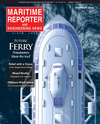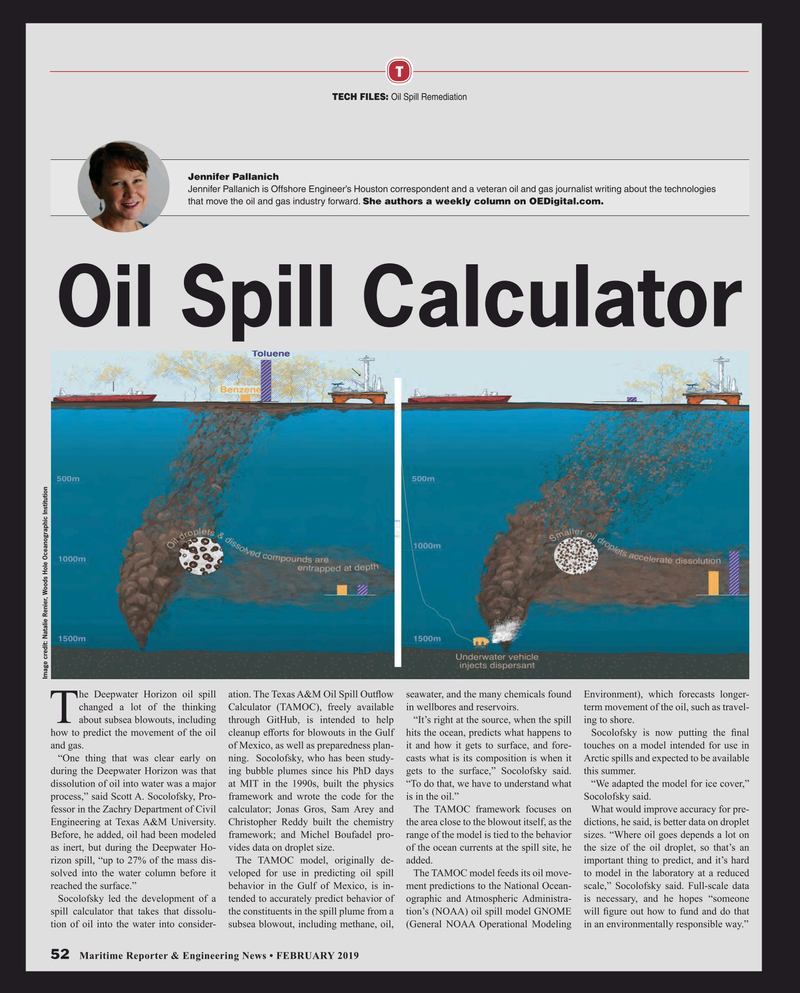
Page 52: of Maritime Reporter Magazine (February 2019)
Ferry Builders
Read this page in Pdf, Flash or Html5 edition of February 2019 Maritime Reporter Magazine
T
TECH FILES: Oil Spill Remediation
Jennifer Pallanich
Jennifer Pallanich is Offshore Engineer’s Houston correspondent and a veteran oil and gas journalist writing about the technologies that move the oil and gas industry forward. She authors a weekly column on OEDigital.com.
Oil Spill Calculator
Image credit: Natalie Renier, Woods Hole Oceanographic Institution he Deepwater Horizon oil spill ation. The Texas A&M Oil Spill Outfow seawater, and the many chemicals found Environment), which forecasts longer- changed a lot of the thinking Calculator (TAMOC), freely available in wellbores and reservoirs. term movement of the oil, such as travel-
Tabout subsea blowouts, including through GitHub, is intended to help “It’s right at the source, when the spill ing to shore.
how to predict the movement of the oil cleanup eforts for blowouts in the Gulf hits the ocean, predicts what happens to Socolofsky is now putting the fnal and gas. of Mexico, as well as preparedness plan- it and how it gets to surface, and fore- touches on a model intended for use in “One thing that was clear early on ning. Socolofsky, who has been study- casts what is its composition is when it Arctic spills and expected to be available during the Deepwater Horizon was that ing bubble plumes since his PhD days gets to the surface,” Socolofsky said. this summer.
dissolution of oil into water was a major at MIT in the 1990s, built the physics “To do that, we have to understand what “We adapted the model for ice cover,” process,” said Scott A. Socolofsky, Pro- framework and wrote the code for the is in the oil.” Socolofsky said.
fessor in the Zachry Department of Civil calculator; Jonas Gros, Sam Arey and The TAMOC framework focuses on What would improve accuracy for pre-
Engineering at Texas A&M University. Christopher Reddy built the chemistry the area close to the blowout itself, as the dictions, he said, is better data on droplet
Before, he added, oil had been modeled framework; and Michel Boufadel pro- range of the model is tied to the behavior sizes. “Where oil goes depends a lot on as inert, but during the Deepwater Ho- vides data on droplet size. of the ocean currents at the spill site, he the size of the oil droplet, so that’s an rizon spill, “up to 27% of the mass dis- The TAMOC model, originally de- added. important thing to predict, and it’s hard solved into the water column before it veloped for use in predicting oil spill The TAMOC model feeds its oil move- to model in the laboratory at a reduced reached the surface.” behavior in the Gulf of Mexico, is in- ment predictions to the National Ocean- scale,” Socolofsky said. Full-scale data
Socolofsky led the development of a tended to accurately predict behavior of ographic and Atmospheric Administra- is necessary, and he hopes “someone spill calculator that takes that dissolu- the constituents in the spill plume from a tion’s (NOAA) oil spill model GNOME will fgure out how to fund and do that tion of oil into the water into consider- subsea blowout, including methane, oil, (General NOAA Operational Modeling in an environmentally responsible way.” 52 Maritime Reporter & Engineering News • FEBRUARY 2019

 51
51

 53
53
